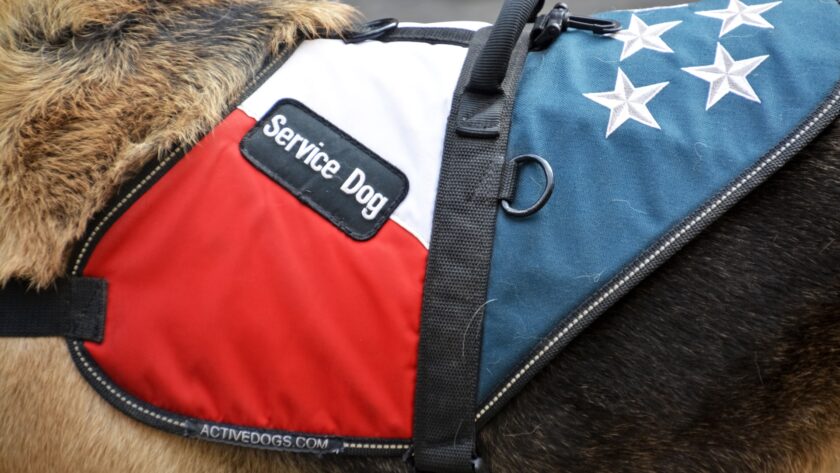So many particular circumstances and limitations define the human race, and using a service animal can significantly improve most of these disabilities. The fascinating thing about these animals is that they can be taught to assist with various problems.
It is amazing how many various kinds of service animals there are. A service animal is a pet that has been carefully trained to carry out specific chores for its owner because they are either unable to do so themselves or would find it extremely difficult to do so on their own.
Due to their intelligence and close ties to humans, dogs are most frequently used as service animals; however, this does not exclude other animals from fulfilling the same role.
On the other hand, service animals are used for a variety of very particular purposes. Service animals are specially trained animals that can carry out their tasks under pressure and comprehend difficult situations.
Since they are highly trained, service animals can be taught to recognize the unique requirements of each handler to whom they are assigned. Thanks to their training, they can now assist people with a wide range of disabilities. Service animals are clever, expertly trained animals that may assist people with various needs and tasks.
Here are some of the typical ways that service animals help their human counterparts live better lives. This is not an exhaustive list of all possible applications for service animals as more are continually discovered.
Impaired hearing
Service animals help those with hearing problems by alerting their owners to sounds like alarms, doorbells, or screaming newborns. The service animals will touch their humans and move toward the sound when it hears it. On top of a service animal, seniors who are returning veterans who have suffered injuries can claim for 100% disability through TDIU, to help boost their income during their time of need.
Animals trained to assist people with hearing problems can also inform their owners if a fire alarm goes off or traffic is coming. This can be as simple as alerting their master when the phone rings or someone knocks on the door. The service animal guide will help you provide health benefits,increase fitness, lower stress, and improve happiness.
Dogs are frequently used as service animals to assist with hearing impairments because of their reputation for exceptional hearing. Using carefully trained hearing-aid dogs has significantly improved the daily lives of many deaf or hard of hearing people.
Patients with diabetes
These service animals can notify their handler of chemical changes in their blood sugar, giving them independence and security. Dogs can pick up on fragrance changes in people with diabetes connected with hyperglycemic or hypoglycemia occurrences that are undetectable to humans.
Still, these animals may pick up on and warn their owners before the levels become problematic. This gives people with diabetes an early warning system to know when they might need to inject themselves with insulin or look for some meal or drink to raise their blood sugar levels.
Diabetes alert dogs give their owners a greater sense of freedom and security, much like other service dogs do. Meanwhile, when their owner requires medical attention, diabetic alert dogs are also taught to inform neighbors or sound an alarm.
Some dogs are even taught to use a special K-9 alert phone to dial 911 if they are left alone at home. Additionally, these canines should have emergency protocols in their vests so that first responders are aware of what to do.
Service animals trained to assist people with diabetes can make a living with the disease considerably less frightening through the assurance that an animal is always watching out for them. Additionally, if a person is disabled or unable to talk, these animals can be trained to call attention to their owners.
Service animals come in handy in emergencies and can assist people in managing life-threatening conditions like diabetes.
Severe Allergies
Dogs trained to identify and alert to the odor of substances like peanuts or gluten include allergy detection dogs. For some with severe allergies, this skill may even save their lives. In our current world, some foods come from unidentified sources and could accidentally include allergies that are difficult to detect.
Service dogs trained to detect particular scents can warn their owners if something unsafe is contained within whatever they are going to consume, whether the dish was unintentionally fried in peanut oil or the package contains allergies.
Vision Impairment
Most of the time, blind or visually impaired people are matched with this kind of service animal. A guide dog frequently wears a U-shaped harness when traveling with its owner. This harness enables the owner to instruct the dog using a sequence of commands.
These canines have been taught to recognize and steer clear of potential hazards inside and outside the house. Service dogs are frequently taught to navigate congested locations, such as city walkways and public transportation.
Blind people who utilize guide animals to help the visually impaired can reclaim their independence and sense of security in society. They can navigate crowded streets and places with the support of a service animal and worry less about running into people or crossing in front of moving cars. These assistance dogs can prevent fatalities and make ordinary activities like grocery shopping much simpler and more enjoyable for their owners.
Sufferers of Seizures
Although trained to help people who suffer seizures, seizure service animals cannot foresee when a seizure will occur. They can, however, activate life-saving alert systems that call for medical assistance, move a person into the correct position, or get hold of drugs that can be given to help stop a seizure.
Additionally, service animals can be taught to roll their handlers on their sides to clear their airways and prevent them from suffocating on vomit or other objects on the floor or obstructing their respiratory passages.
When trained as service animals for people with seizures, they are frequently taught to help the client from hurting themselves when they fall and stop them from rolling into the road or other barriers. Additionally, these service animals are taught to draw attention to their owners so that others can help them or call for help from emergency services.
Conclusion
Service animals are not just dogs. The most popular kind of service animal is the dog, but they can also be exceptionally trained to provide support to humans daily. People with disabilities, ranging from autism to muscular dystrophy, greatly benefit from service dogs.
These devoted pets assist their owners with daily chores, and some have been specially trained to help those who suffer from diabetes, epilepsy, or PTSD. In addition to becoming devoted friends, service dogs play a significant practical role in the lives of their partners.





